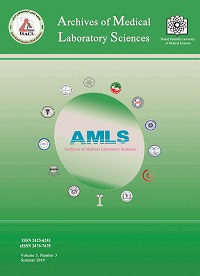Assessment of the antibacterial potential of Aloe vera as a source of antibacterial agents
Archives of Medical Laboratory Sciences,
Vol. 5 No. 3 (2019),
1 July 2019,
Page 21-25
https://doi.org/10.22037/amls.v5i3.30773
Background: Nowadays the use of herbs as an alternative to the chemical drug is considered by researchers. Aloe vera belongs to the Asphodelaceae family, a medicinal plant that has been used since ancient times for different pharmaceutical products. This study aimed to evaluate the antibacterial properties of Aloe vera grown in Khouzestan, southwest of Iran.
Materials and Methods:For this purpose, ethanol extract was prepared from aerial parts of Aloe vera and its activity was tested against some gram-positive (Enterococcus faecalis, Staphylococcus aureus, Bacillus cereus) and gram-negative (Pseudomonass aeruginosa, Salmonella Typhi, Proteus mirabilis) bacterial species through standard Kirby-Bauer disc diffusion method. Minimum inhibitory concentration and minimum bactericidal concentration were also investigated.
Results: The Aloe vera extract showed antibacterial activity against the majority of bacteria. The highest activity (about 25mm inhibition zone) happened against P. aeruginosa but it did not show any inhibitory activity against S.aureus and P. mirabilis. The MIC was found as 10 mg/ml while MBC ≥ 80.
Conclusion: Based on the results of this study it can be suggested that Aloe vera contains active antibacterial substances that can be used efficiently for bacterial pathogen control and it should be considered as a potent antimicrobial source for finding new antibiotics, especially against resistant species.
